ITECH1102: Networking and Security Report - University Assignment
VerifiedAdded on 2023/06/04
|12
|2470
|300
Report
AI Summary
This report provides a comprehensive overview of computer networking and security, beginning with definitions and types of data exchange, and then exploring various network devices such as switches and routers. It delves into the Internet model (TCP/IP) and the Open Systems Interconnection (OSI) model, detailing each layer and its functionalities, including the application, physical, data link, internet, and transport layers. The report examines network protocols, switching methods, and transmission media, providing insights into data flow and multiplexing techniques. It also covers the role of protocols in ensuring successful network communication. The report concludes with references to relevant research papers and articles. This document serves as a valuable resource for students studying networking and security, offering a detailed understanding of key concepts and technologies.

Running Head: NETWORK AND SECURITY 1
Network and Security
Student’s Name
University Affiliation
Network and Security
Student’s Name
University Affiliation
Paraphrase This Document
Need a fresh take? Get an instant paraphrase of this document with our AI Paraphraser
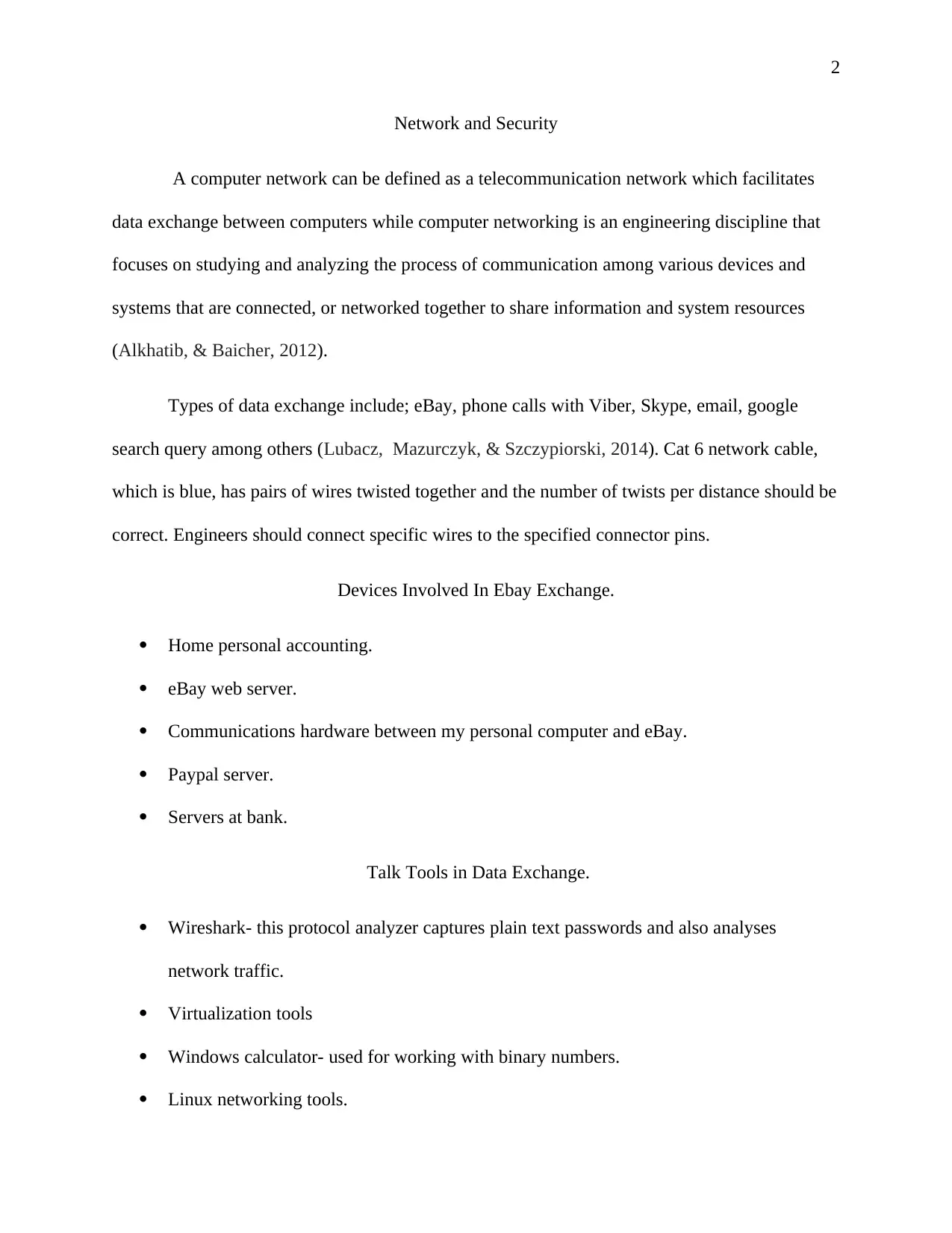
2
Network and Security
A computer network can be defined as a telecommunication network which facilitates
data exchange between computers while computer networking is an engineering discipline that
focuses on studying and analyzing the process of communication among various devices and
systems that are connected, or networked together to share information and system resources
(Alkhatib, & Baicher, 2012).
Types of data exchange include; eBay, phone calls with Viber, Skype, email, google
search query among others (Lubacz, Mazurczyk, & Szczypiorski, 2014). Cat 6 network cable,
which is blue, has pairs of wires twisted together and the number of twists per distance should be
correct. Engineers should connect specific wires to the specified connector pins.
Devices Involved In Ebay Exchange.
Home personal accounting.
eBay web server.
Communications hardware between my personal computer and eBay.
Paypal server.
Servers at bank.
Talk Tools in Data Exchange.
Wireshark- this protocol analyzer captures plain text passwords and also analyses
network traffic.
Virtualization tools
Windows calculator- used for working with binary numbers.
Linux networking tools.
Network and Security
A computer network can be defined as a telecommunication network which facilitates
data exchange between computers while computer networking is an engineering discipline that
focuses on studying and analyzing the process of communication among various devices and
systems that are connected, or networked together to share information and system resources
(Alkhatib, & Baicher, 2012).
Types of data exchange include; eBay, phone calls with Viber, Skype, email, google
search query among others (Lubacz, Mazurczyk, & Szczypiorski, 2014). Cat 6 network cable,
which is blue, has pairs of wires twisted together and the number of twists per distance should be
correct. Engineers should connect specific wires to the specified connector pins.
Devices Involved In Ebay Exchange.
Home personal accounting.
eBay web server.
Communications hardware between my personal computer and eBay.
Paypal server.
Servers at bank.
Talk Tools in Data Exchange.
Wireshark- this protocol analyzer captures plain text passwords and also analyses
network traffic.
Virtualization tools
Windows calculator- used for working with binary numbers.
Linux networking tools.
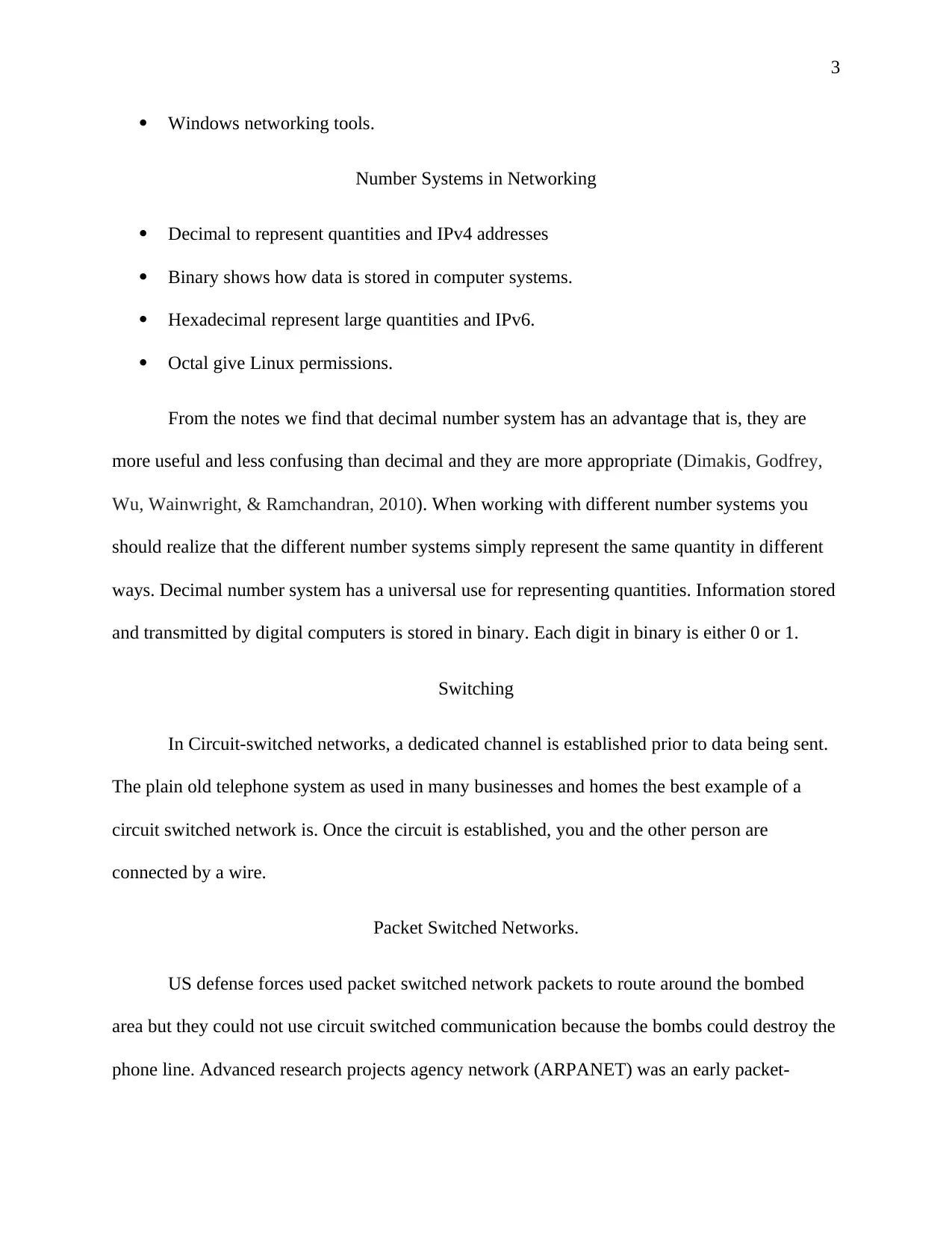
3
Windows networking tools.
Number Systems in Networking
Decimal to represent quantities and IPv4 addresses
Binary shows how data is stored in computer systems.
Hexadecimal represent large quantities and IPv6.
Octal give Linux permissions.
From the notes we find that decimal number system has an advantage that is, they are
more useful and less confusing than decimal and they are more appropriate (Dimakis, Godfrey,
Wu, Wainwright, & Ramchandran, 2010). When working with different number systems you
should realize that the different number systems simply represent the same quantity in different
ways. Decimal number system has a universal use for representing quantities. Information stored
and transmitted by digital computers is stored in binary. Each digit in binary is either 0 or 1.
Switching
In Circuit-switched networks, a dedicated channel is established prior to data being sent.
The plain old telephone system as used in many businesses and homes the best example of a
circuit switched network is. Once the circuit is established, you and the other person are
connected by a wire.
Packet Switched Networks.
US defense forces used packet switched network packets to route around the bombed
area but they could not use circuit switched communication because the bombs could destroy the
phone line. Advanced research projects agency network (ARPANET) was an early packet-
Windows networking tools.
Number Systems in Networking
Decimal to represent quantities and IPv4 addresses
Binary shows how data is stored in computer systems.
Hexadecimal represent large quantities and IPv6.
Octal give Linux permissions.
From the notes we find that decimal number system has an advantage that is, they are
more useful and less confusing than decimal and they are more appropriate (Dimakis, Godfrey,
Wu, Wainwright, & Ramchandran, 2010). When working with different number systems you
should realize that the different number systems simply represent the same quantity in different
ways. Decimal number system has a universal use for representing quantities. Information stored
and transmitted by digital computers is stored in binary. Each digit in binary is either 0 or 1.
Switching
In Circuit-switched networks, a dedicated channel is established prior to data being sent.
The plain old telephone system as used in many businesses and homes the best example of a
circuit switched network is. Once the circuit is established, you and the other person are
connected by a wire.
Packet Switched Networks.
US defense forces used packet switched network packets to route around the bombed
area but they could not use circuit switched communication because the bombs could destroy the
phone line. Advanced research projects agency network (ARPANET) was an early packet-
⊘ This is a preview!⊘
Do you want full access?
Subscribe today to unlock all pages.

Trusted by 1+ million students worldwide
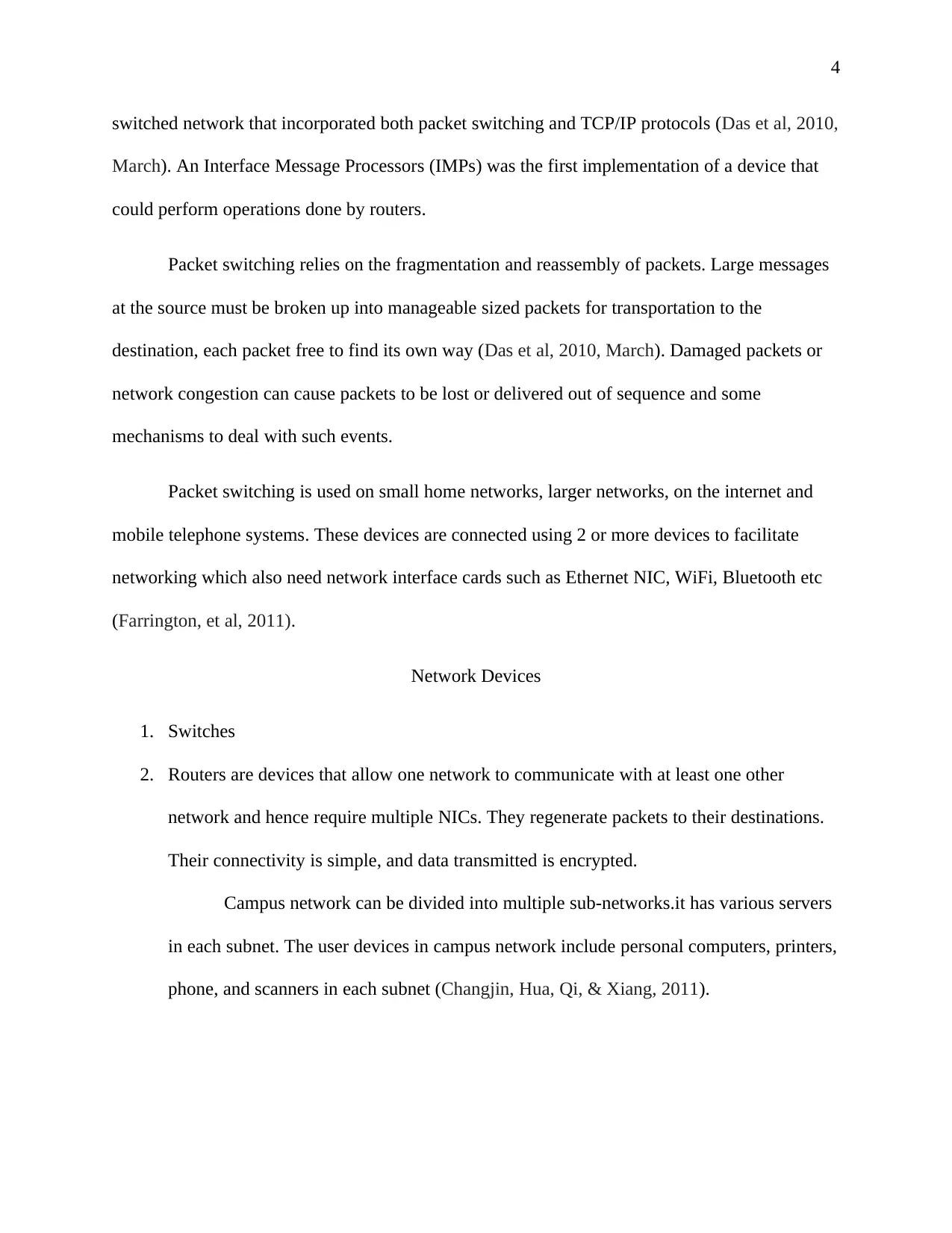
4
switched network that incorporated both packet switching and TCP/IP protocols (Das et al, 2010,
March). An Interface Message Processors (IMPs) was the first implementation of a device that
could perform operations done by routers.
Packet switching relies on the fragmentation and reassembly of packets. Large messages
at the source must be broken up into manageable sized packets for transportation to the
destination, each packet free to find its own way (Das et al, 2010, March). Damaged packets or
network congestion can cause packets to be lost or delivered out of sequence and some
mechanisms to deal with such events.
Packet switching is used on small home networks, larger networks, on the internet and
mobile telephone systems. These devices are connected using 2 or more devices to facilitate
networking which also need network interface cards such as Ethernet NIC, WiFi, Bluetooth etc
(Farrington, et al, 2011).
Network Devices
1. Switches
2. Routers are devices that allow one network to communicate with at least one other
network and hence require multiple NICs. They regenerate packets to their destinations.
Their connectivity is simple, and data transmitted is encrypted.
Campus network can be divided into multiple sub-networks.it has various servers
in each subnet. The user devices in campus network include personal computers, printers,
phone, and scanners in each subnet (Changjin, Hua, Qi, & Xiang, 2011).
switched network that incorporated both packet switching and TCP/IP protocols (Das et al, 2010,
March). An Interface Message Processors (IMPs) was the first implementation of a device that
could perform operations done by routers.
Packet switching relies on the fragmentation and reassembly of packets. Large messages
at the source must be broken up into manageable sized packets for transportation to the
destination, each packet free to find its own way (Das et al, 2010, March). Damaged packets or
network congestion can cause packets to be lost or delivered out of sequence and some
mechanisms to deal with such events.
Packet switching is used on small home networks, larger networks, on the internet and
mobile telephone systems. These devices are connected using 2 or more devices to facilitate
networking which also need network interface cards such as Ethernet NIC, WiFi, Bluetooth etc
(Farrington, et al, 2011).
Network Devices
1. Switches
2. Routers are devices that allow one network to communicate with at least one other
network and hence require multiple NICs. They regenerate packets to their destinations.
Their connectivity is simple, and data transmitted is encrypted.
Campus network can be divided into multiple sub-networks.it has various servers
in each subnet. The user devices in campus network include personal computers, printers,
phone, and scanners in each subnet (Changjin, Hua, Qi, & Xiang, 2011).
Paraphrase This Document
Need a fresh take? Get an instant paraphrase of this document with our AI Paraphraser

5
Internet is a computer network linking smaller computer worldwide. Each
network on the internet is identified by a unique network ID which allows traffic to
traverse intermediary network.
The Internet Model (TCP/IP)
This model gives us a framework with which to understand how networking
works from a TCP/IP perspective (Alani, 2014). This model has five layers which
include:
Application layer
Transport layer- provides packet reassembly and reliable data transfers. TCP
operates in this layer.
Internet layer
Data link layer
Physical layer
The Open Systems Interconnection (OSI) model
It defines a theoretical networking framework to explain networking in seven layers (Bora, Bora,
Singh, & Arsalan, 2014).
1. The Application Layer
This layer allows user to interact with the internet by providing user interfaces (Bora, Bora,
Singh, & Arsalan, 2014). User applications allows many services and devices on the internet and
on our local network. Categories of interaction are:
Client/server architecture- clients can be web clients, email clients who request services
of servers, for example, requesting files from file servers. Servers waits for client requests
Internet is a computer network linking smaller computer worldwide. Each
network on the internet is identified by a unique network ID which allows traffic to
traverse intermediary network.
The Internet Model (TCP/IP)
This model gives us a framework with which to understand how networking
works from a TCP/IP perspective (Alani, 2014). This model has five layers which
include:
Application layer
Transport layer- provides packet reassembly and reliable data transfers. TCP
operates in this layer.
Internet layer
Data link layer
Physical layer
The Open Systems Interconnection (OSI) model
It defines a theoretical networking framework to explain networking in seven layers (Bora, Bora,
Singh, & Arsalan, 2014).
1. The Application Layer
This layer allows user to interact with the internet by providing user interfaces (Bora, Bora,
Singh, & Arsalan, 2014). User applications allows many services and devices on the internet and
on our local network. Categories of interaction are:
Client/server architecture- clients can be web clients, email clients who request services
of servers, for example, requesting files from file servers. Servers waits for client requests
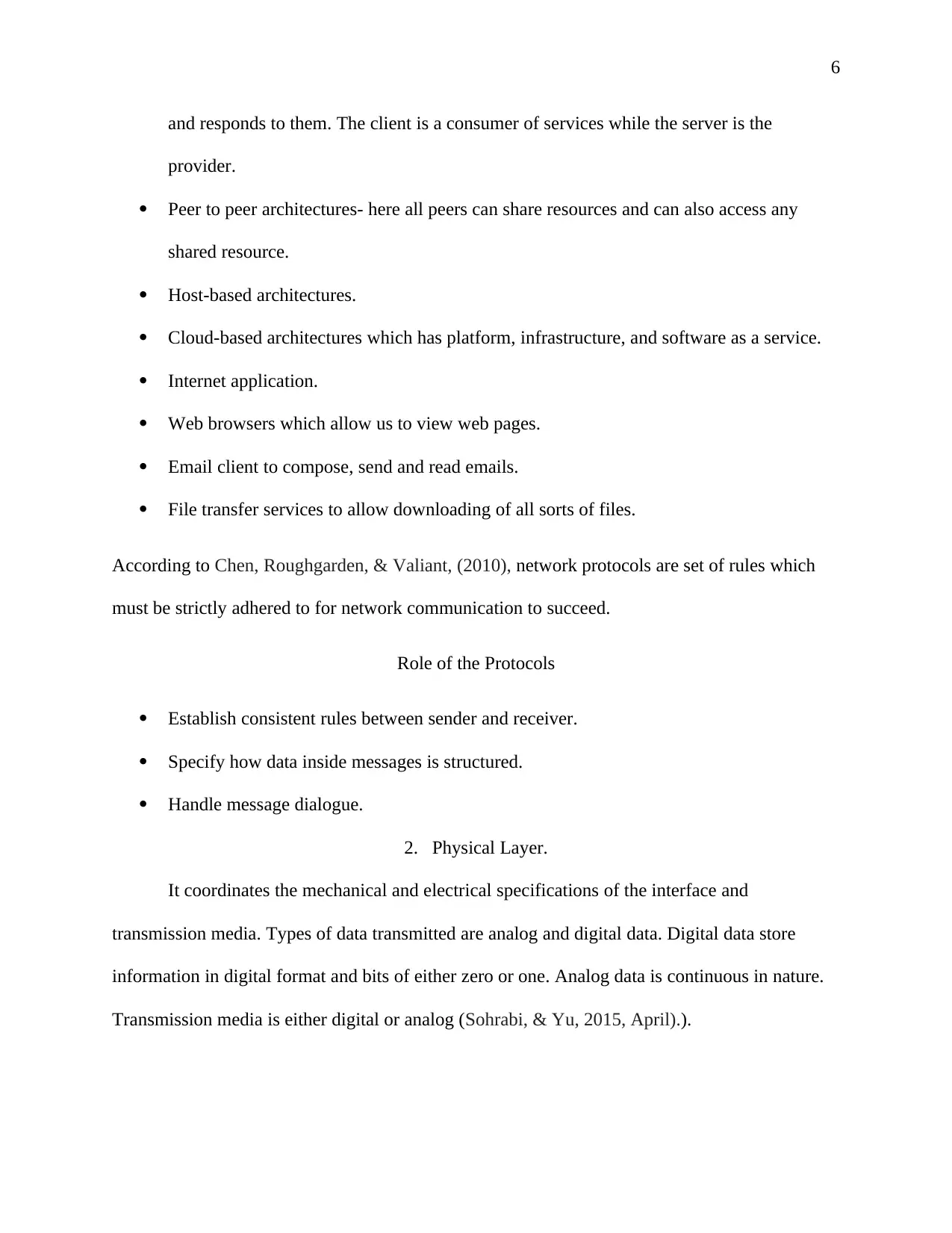
6
and responds to them. The client is a consumer of services while the server is the
provider.
Peer to peer architectures- here all peers can share resources and can also access any
shared resource.
Host-based architectures.
Cloud-based architectures which has platform, infrastructure, and software as a service.
Internet application.
Web browsers which allow us to view web pages.
Email client to compose, send and read emails.
File transfer services to allow downloading of all sorts of files.
According to Chen, Roughgarden, & Valiant, (2010), network protocols are set of rules which
must be strictly adhered to for network communication to succeed.
Role of the Protocols
Establish consistent rules between sender and receiver.
Specify how data inside messages is structured.
Handle message dialogue.
2. Physical Layer.
It coordinates the mechanical and electrical specifications of the interface and
transmission media. Types of data transmitted are analog and digital data. Digital data store
information in digital format and bits of either zero or one. Analog data is continuous in nature.
Transmission media is either digital or analog (Sohrabi, & Yu, 2015, April).).
and responds to them. The client is a consumer of services while the server is the
provider.
Peer to peer architectures- here all peers can share resources and can also access any
shared resource.
Host-based architectures.
Cloud-based architectures which has platform, infrastructure, and software as a service.
Internet application.
Web browsers which allow us to view web pages.
Email client to compose, send and read emails.
File transfer services to allow downloading of all sorts of files.
According to Chen, Roughgarden, & Valiant, (2010), network protocols are set of rules which
must be strictly adhered to for network communication to succeed.
Role of the Protocols
Establish consistent rules between sender and receiver.
Specify how data inside messages is structured.
Handle message dialogue.
2. Physical Layer.
It coordinates the mechanical and electrical specifications of the interface and
transmission media. Types of data transmitted are analog and digital data. Digital data store
information in digital format and bits of either zero or one. Analog data is continuous in nature.
Transmission media is either digital or analog (Sohrabi, & Yu, 2015, April).).
⊘ This is a preview!⊘
Do you want full access?
Subscribe today to unlock all pages.

Trusted by 1+ million students worldwide
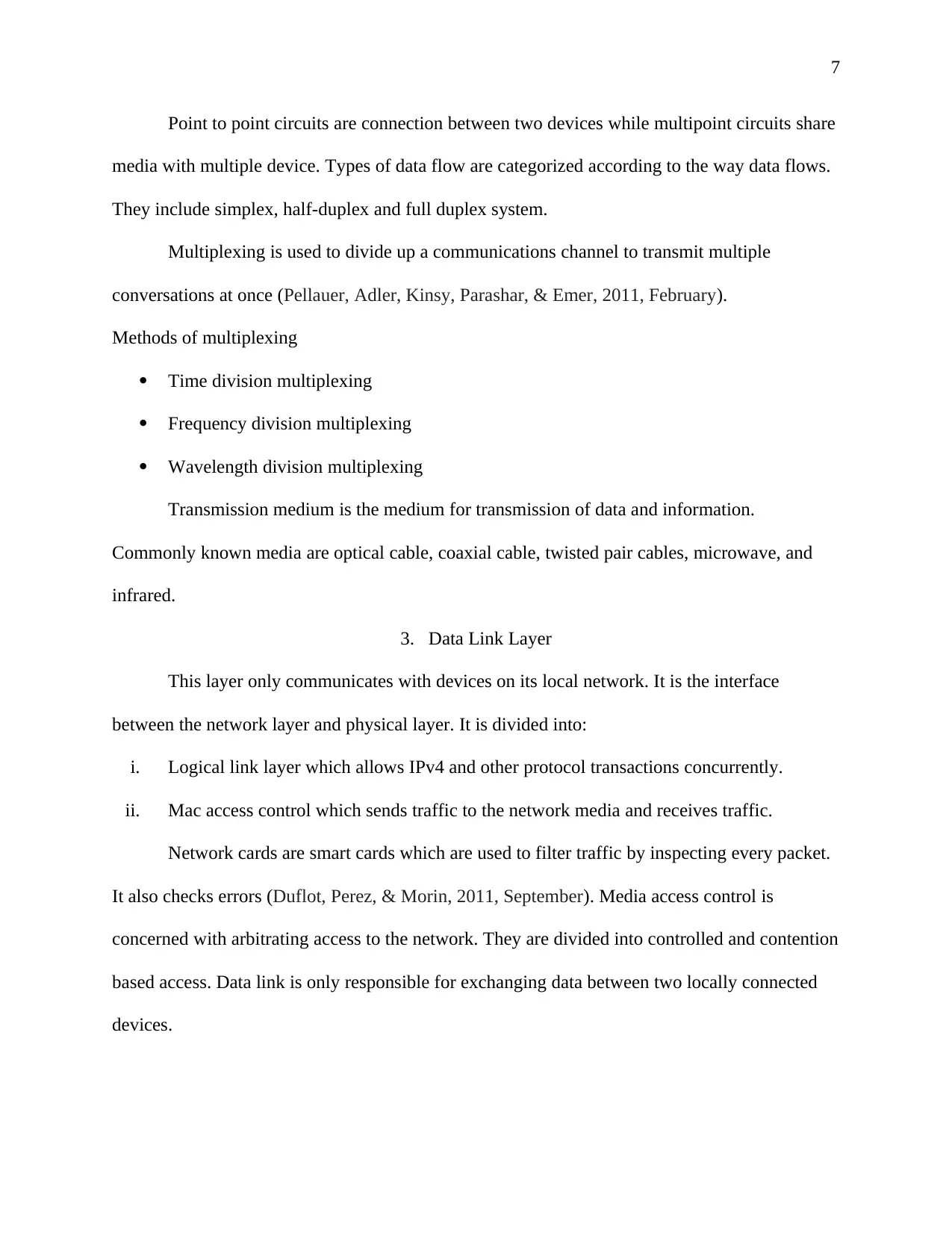
7
Point to point circuits are connection between two devices while multipoint circuits share
media with multiple device. Types of data flow are categorized according to the way data flows.
They include simplex, half-duplex and full duplex system.
Multiplexing is used to divide up a communications channel to transmit multiple
conversations at once (Pellauer, Adler, Kinsy, Parashar, & Emer, 2011, February).
Methods of multiplexing
Time division multiplexing
Frequency division multiplexing
Wavelength division multiplexing
Transmission medium is the medium for transmission of data and information.
Commonly known media are optical cable, coaxial cable, twisted pair cables, microwave, and
infrared.
3. Data Link Layer
This layer only communicates with devices on its local network. It is the interface
between the network layer and physical layer. It is divided into:
i. Logical link layer which allows IPv4 and other protocol transactions concurrently.
ii. Mac access control which sends traffic to the network media and receives traffic.
Network cards are smart cards which are used to filter traffic by inspecting every packet.
It also checks errors (Duflot, Perez, & Morin, 2011, September). Media access control is
concerned with arbitrating access to the network. They are divided into controlled and contention
based access. Data link is only responsible for exchanging data between two locally connected
devices.
Point to point circuits are connection between two devices while multipoint circuits share
media with multiple device. Types of data flow are categorized according to the way data flows.
They include simplex, half-duplex and full duplex system.
Multiplexing is used to divide up a communications channel to transmit multiple
conversations at once (Pellauer, Adler, Kinsy, Parashar, & Emer, 2011, February).
Methods of multiplexing
Time division multiplexing
Frequency division multiplexing
Wavelength division multiplexing
Transmission medium is the medium for transmission of data and information.
Commonly known media are optical cable, coaxial cable, twisted pair cables, microwave, and
infrared.
3. Data Link Layer
This layer only communicates with devices on its local network. It is the interface
between the network layer and physical layer. It is divided into:
i. Logical link layer which allows IPv4 and other protocol transactions concurrently.
ii. Mac access control which sends traffic to the network media and receives traffic.
Network cards are smart cards which are used to filter traffic by inspecting every packet.
It also checks errors (Duflot, Perez, & Morin, 2011, September). Media access control is
concerned with arbitrating access to the network. They are divided into controlled and contention
based access. Data link is only responsible for exchanging data between two locally connected
devices.
Paraphrase This Document
Need a fresh take? Get an instant paraphrase of this document with our AI Paraphraser

8
4. Internet Layer
The role of this layer is to deliver network traffic from one host to another. It is all about
IP addressing and associated routing. Every device on IP network requires an IP address which
uniquely identify a device from others on the internet (Stanley, Shai, Taylor, & Mucha, 2016).
There are two versions of IP addresses which are:
IPv4 which are 32 bits long.
IPv6 which are 128 bits long and is the newest version of the internet protocol. IPv6 is
expressed by use of hexadecimal.
Devices get IP addresses either manually or automatically. IP address has network bits
that are common to all hosts on an IP network and node bits that specify a particular host on that
network. IP addresses can also be private or public. Public can communicate on the internet
while private cannot travel on the internet and are discarded by routers (Stanley, Shai, Taylor, &
Mucha, 2016).
Private ranges are: 10.0.0.0/8 – 10.255.255.255
172.16.0.0/12 – 172.31.255.255
192.168.0.0 – 192.168.255.255
Routers move packets to their destination. They require routing table of the internetwork
to decide which route to use. They communicate with one another to ensure all routers know the
changes made in the network. Internet Assigned Numbers Authority (IANA) is a company body
which names internet domains.
4. Internet Layer
The role of this layer is to deliver network traffic from one host to another. It is all about
IP addressing and associated routing. Every device on IP network requires an IP address which
uniquely identify a device from others on the internet (Stanley, Shai, Taylor, & Mucha, 2016).
There are two versions of IP addresses which are:
IPv4 which are 32 bits long.
IPv6 which are 128 bits long and is the newest version of the internet protocol. IPv6 is
expressed by use of hexadecimal.
Devices get IP addresses either manually or automatically. IP address has network bits
that are common to all hosts on an IP network and node bits that specify a particular host on that
network. IP addresses can also be private or public. Public can communicate on the internet
while private cannot travel on the internet and are discarded by routers (Stanley, Shai, Taylor, &
Mucha, 2016).
Private ranges are: 10.0.0.0/8 – 10.255.255.255
172.16.0.0/12 – 172.31.255.255
192.168.0.0 – 192.168.255.255
Routers move packets to their destination. They require routing table of the internetwork
to decide which route to use. They communicate with one another to ensure all routers know the
changes made in the network. Internet Assigned Numbers Authority (IANA) is a company body
which names internet domains.

9
5. Transport Layer
This layer breaks up large streams of data into small segments to enable easy handling
and access to the network in a process known as segmentation. These segments are then
reassembled in the format in which they were sent or in the format they were delivered.
Identification of application is done here by allocating them a port number. A socket identifies
where transport layer ends.
According to Alani, (2014), UDP is a connectionless protocol for transport services
which is good for video and audio streaming. The UDP header clearly shows the port numbers of
source and destination.
TCP is a connection-oriented protocol for reliable delivery of data but it is slower than UDP.
Timers are put by TCP to detect segments which are lost but it can lead to duplication of
segments. Flow control balances flow of data for slow receivers from fast senders.
Three-Way Handshake of TCP Connections
Facilitates two ends of a connection.
Server responds to the client.
Client approves the response.
5. Transport Layer
This layer breaks up large streams of data into small segments to enable easy handling
and access to the network in a process known as segmentation. These segments are then
reassembled in the format in which they were sent or in the format they were delivered.
Identification of application is done here by allocating them a port number. A socket identifies
where transport layer ends.
According to Alani, (2014), UDP is a connectionless protocol for transport services
which is good for video and audio streaming. The UDP header clearly shows the port numbers of
source and destination.
TCP is a connection-oriented protocol for reliable delivery of data but it is slower than UDP.
Timers are put by TCP to detect segments which are lost but it can lead to duplication of
segments. Flow control balances flow of data for slow receivers from fast senders.
Three-Way Handshake of TCP Connections
Facilitates two ends of a connection.
Server responds to the client.
Client approves the response.
⊘ This is a preview!⊘
Do you want full access?
Subscribe today to unlock all pages.

Trusted by 1+ million students worldwide
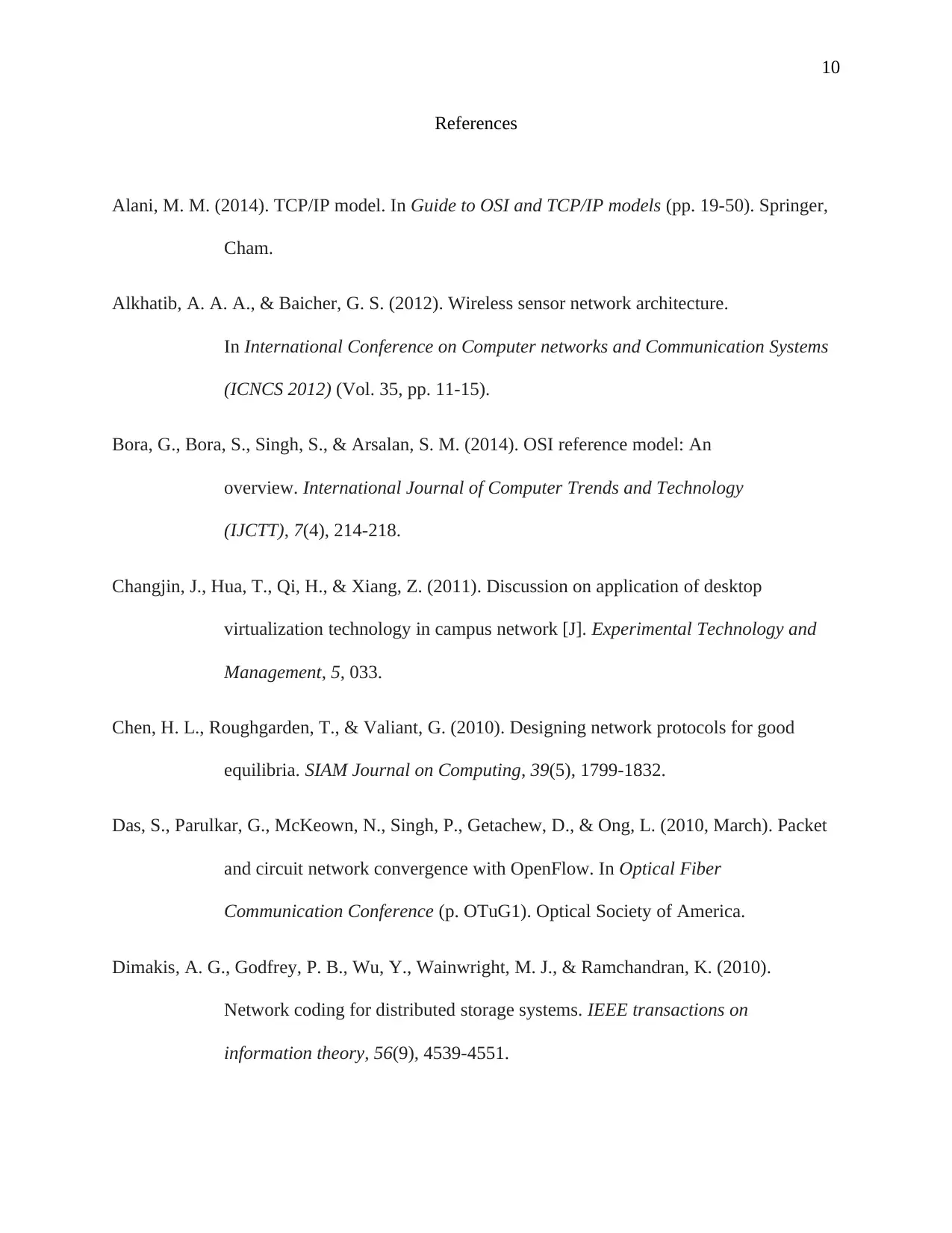
10
References
Alani, M. M. (2014). TCP/IP model. In Guide to OSI and TCP/IP models (pp. 19-50). Springer,
Cham.
Alkhatib, A. A. A., & Baicher, G. S. (2012). Wireless sensor network architecture.
In International Conference on Computer networks and Communication Systems
(ICNCS 2012) (Vol. 35, pp. 11-15).
Bora, G., Bora, S., Singh, S., & Arsalan, S. M. (2014). OSI reference model: An
overview. International Journal of Computer Trends and Technology
(IJCTT), 7(4), 214-218.
Changjin, J., Hua, T., Qi, H., & Xiang, Z. (2011). Discussion on application of desktop
virtualization technology in campus network [J]. Experimental Technology and
Management, 5, 033.
Chen, H. L., Roughgarden, T., & Valiant, G. (2010). Designing network protocols for good
equilibria. SIAM Journal on Computing, 39(5), 1799-1832.
Das, S., Parulkar, G., McKeown, N., Singh, P., Getachew, D., & Ong, L. (2010, March). Packet
and circuit network convergence with OpenFlow. In Optical Fiber
Communication Conference (p. OTuG1). Optical Society of America.
Dimakis, A. G., Godfrey, P. B., Wu, Y., Wainwright, M. J., & Ramchandran, K. (2010).
Network coding for distributed storage systems. IEEE transactions on
information theory, 56(9), 4539-4551.
References
Alani, M. M. (2014). TCP/IP model. In Guide to OSI and TCP/IP models (pp. 19-50). Springer,
Cham.
Alkhatib, A. A. A., & Baicher, G. S. (2012). Wireless sensor network architecture.
In International Conference on Computer networks and Communication Systems
(ICNCS 2012) (Vol. 35, pp. 11-15).
Bora, G., Bora, S., Singh, S., & Arsalan, S. M. (2014). OSI reference model: An
overview. International Journal of Computer Trends and Technology
(IJCTT), 7(4), 214-218.
Changjin, J., Hua, T., Qi, H., & Xiang, Z. (2011). Discussion on application of desktop
virtualization technology in campus network [J]. Experimental Technology and
Management, 5, 033.
Chen, H. L., Roughgarden, T., & Valiant, G. (2010). Designing network protocols for good
equilibria. SIAM Journal on Computing, 39(5), 1799-1832.
Das, S., Parulkar, G., McKeown, N., Singh, P., Getachew, D., & Ong, L. (2010, March). Packet
and circuit network convergence with OpenFlow. In Optical Fiber
Communication Conference (p. OTuG1). Optical Society of America.
Dimakis, A. G., Godfrey, P. B., Wu, Y., Wainwright, M. J., & Ramchandran, K. (2010).
Network coding for distributed storage systems. IEEE transactions on
information theory, 56(9), 4539-4551.
Paraphrase This Document
Need a fresh take? Get an instant paraphrase of this document with our AI Paraphraser
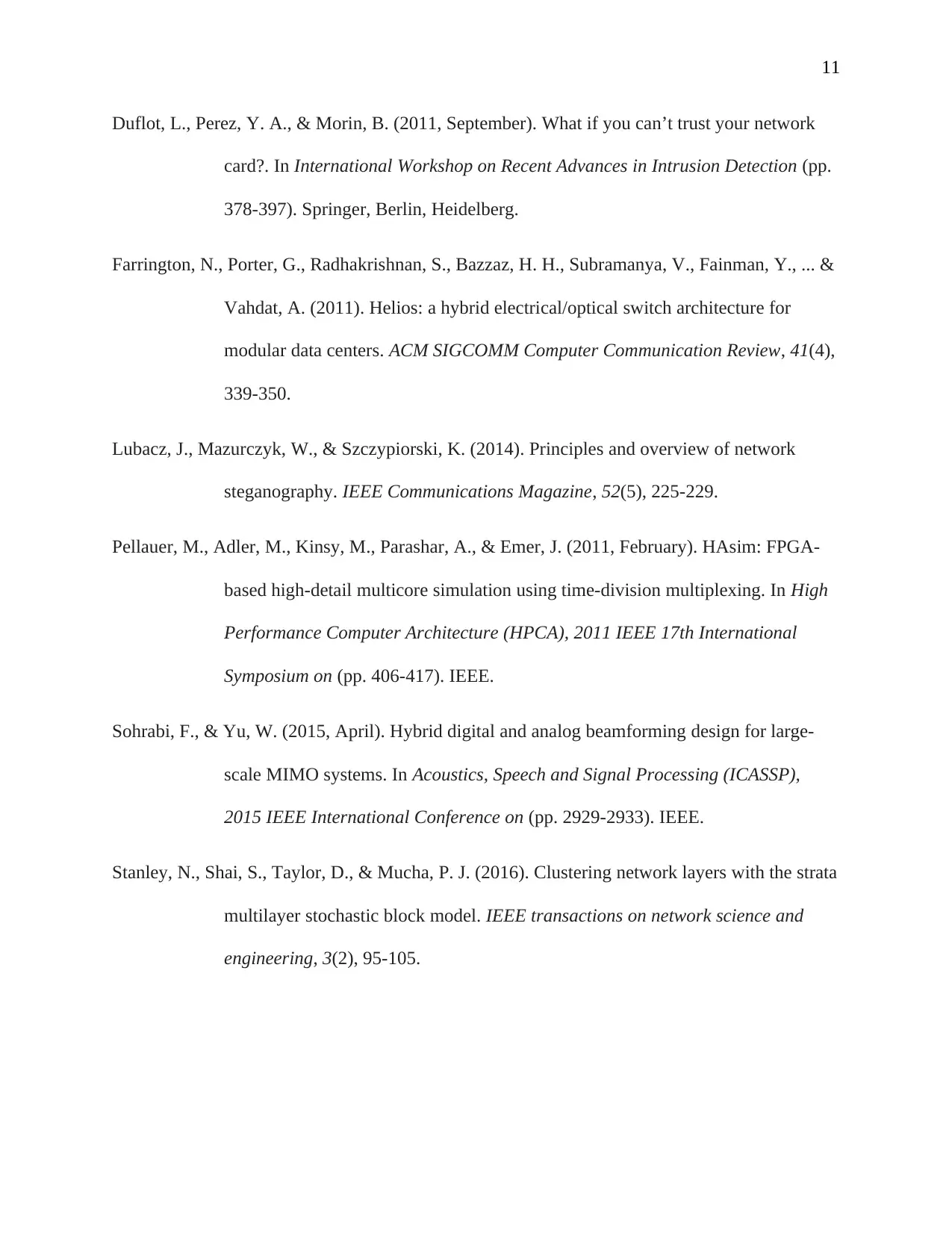
11
Duflot, L., Perez, Y. A., & Morin, B. (2011, September). What if you can’t trust your network
card?. In International Workshop on Recent Advances in Intrusion Detection (pp.
378-397). Springer, Berlin, Heidelberg.
Farrington, N., Porter, G., Radhakrishnan, S., Bazzaz, H. H., Subramanya, V., Fainman, Y., ... &
Vahdat, A. (2011). Helios: a hybrid electrical/optical switch architecture for
modular data centers. ACM SIGCOMM Computer Communication Review, 41(4),
339-350.
Lubacz, J., Mazurczyk, W., & Szczypiorski, K. (2014). Principles and overview of network
steganography. IEEE Communications Magazine, 52(5), 225-229.
Pellauer, M., Adler, M., Kinsy, M., Parashar, A., & Emer, J. (2011, February). HAsim: FPGA-
based high-detail multicore simulation using time-division multiplexing. In High
Performance Computer Architecture (HPCA), 2011 IEEE 17th International
Symposium on (pp. 406-417). IEEE.
Sohrabi, F., & Yu, W. (2015, April). Hybrid digital and analog beamforming design for large-
scale MIMO systems. In Acoustics, Speech and Signal Processing (ICASSP),
2015 IEEE International Conference on (pp. 2929-2933). IEEE.
Stanley, N., Shai, S., Taylor, D., & Mucha, P. J. (2016). Clustering network layers with the strata
multilayer stochastic block model. IEEE transactions on network science and
engineering, 3(2), 95-105.
Duflot, L., Perez, Y. A., & Morin, B. (2011, September). What if you can’t trust your network
card?. In International Workshop on Recent Advances in Intrusion Detection (pp.
378-397). Springer, Berlin, Heidelberg.
Farrington, N., Porter, G., Radhakrishnan, S., Bazzaz, H. H., Subramanya, V., Fainman, Y., ... &
Vahdat, A. (2011). Helios: a hybrid electrical/optical switch architecture for
modular data centers. ACM SIGCOMM Computer Communication Review, 41(4),
339-350.
Lubacz, J., Mazurczyk, W., & Szczypiorski, K. (2014). Principles and overview of network
steganography. IEEE Communications Magazine, 52(5), 225-229.
Pellauer, M., Adler, M., Kinsy, M., Parashar, A., & Emer, J. (2011, February). HAsim: FPGA-
based high-detail multicore simulation using time-division multiplexing. In High
Performance Computer Architecture (HPCA), 2011 IEEE 17th International
Symposium on (pp. 406-417). IEEE.
Sohrabi, F., & Yu, W. (2015, April). Hybrid digital and analog beamforming design for large-
scale MIMO systems. In Acoustics, Speech and Signal Processing (ICASSP),
2015 IEEE International Conference on (pp. 2929-2933). IEEE.
Stanley, N., Shai, S., Taylor, D., & Mucha, P. J. (2016). Clustering network layers with the strata
multilayer stochastic block model. IEEE transactions on network science and
engineering, 3(2), 95-105.

12
⊘ This is a preview!⊘
Do you want full access?
Subscribe today to unlock all pages.

Trusted by 1+ million students worldwide
1 out of 12
Related Documents
Your All-in-One AI-Powered Toolkit for Academic Success.
+13062052269
info@desklib.com
Available 24*7 on WhatsApp / Email
![[object Object]](/_next/static/media/star-bottom.7253800d.svg)
Unlock your academic potential
Copyright © 2020–2025 A2Z Services. All Rights Reserved. Developed and managed by ZUCOL.




